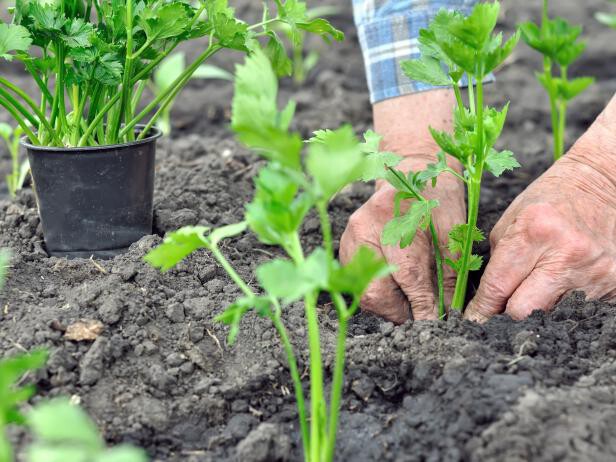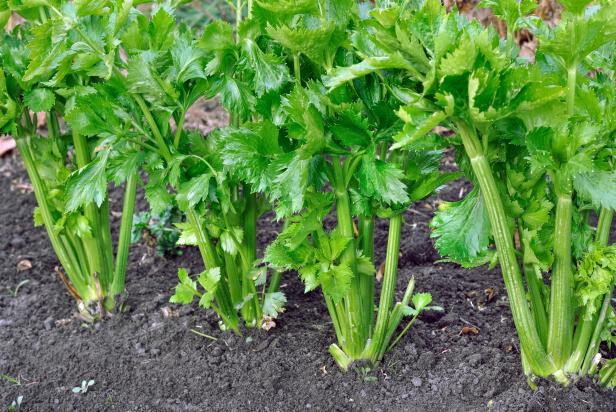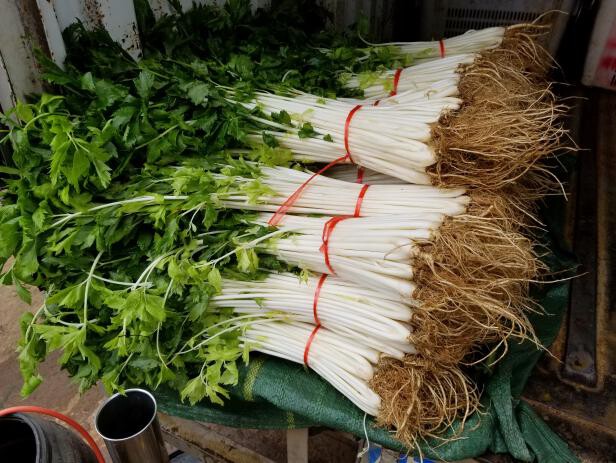
The secret to getting celery seed to sprout is soaking seeds for 24 to 48 hours before planting. When sowing, barely cover seeds or even leave them uncovered. Germination occurs in seven days with soil temps of 70 degrees Fahrenheit.
Planting Celery Seedlings
Give celery a spot in full sun for best growth. In the hottest regions, shade plants during the hottest part of the day. Celery needs a rich soil with lots of organic matter. Plants have a small, shallow root system that's only 2" to 3" deep with a spread of 6" to 8". This means that you want to give the plant what it needs to thrive in those first few inches of soil.
Amend the planting bed with plenty of compost or rotted manure, adding more compost to each planting hole. Space plants 8 inches apart. You can grow roughly 12 plants in 5' to 6' of row space. In a raised bed, you can even tuck them along one end or in the corners.
Don't plant celery seedlings in the garden until day temperatures stay reliably above 55 degrees Fahrenheit and nights are above 40 degrees Fahrenheit. If you plant too early and the weather becomes cold (under 55 degrees Fahrenheit) for two weeks, seedlings may bolt and form seed.

Another alternative for growing celery is simply to use a stalk you buy at the store. Cut off the bottom 2 inches of the stalk, tuck the root end into a pot of soil or your garden, water and wait for it to grow. Just make sure you don't put plants outside until it's warm enough.
Tips for Growing Celery
·Water: Celery must not dry out, or it becomes bitter and stringy. Dry spells also produce pithy or even hollow stems. Give plants a consistent moisture supply. Working compost into soil helps soil to retain water.
·Mulch: Adding a mulch layer around celery plants helps soil stay moist longer and protects shallow roots from drying.
·Fertilizer: Keep celery growing steadily by feeding it throughout the growing season with a balanced fertilizer such as fish emulsion or 5-10-10. Apply fertilizer once during the second and third month of the crop cycle. You can also water plants with manure tea weekly.
·Weeding: Celery's shallow roots means that it doesn't compete well with weeds. Keep the planting area free of weeds. Mulch can help with suppressing weeds.
Blanching Celery
Blanching is the process of covering the celery stalk to keep sunlight from reaching the stems. Doing this shifts stem color from deep green to light green and changes stem flavor from bitter to sweet. It yields a celery that tastes more like what you would buy from the store. When you blanch celery, stems stretch upward, which helps reduce stringiness. Unblanched celery has a stronger flavor (it can shift to bitter) and also more nutrients in those dark green stems. The time to blanch celery is anywhere from 10 to 21 days before harvesting.
To blanch celery, cover the upright stems, keeping the leaves uncovered so they continue to photosynthesize and feed the plant. Unleash your creativity for this task. All you need is some kind of sleeve to slip over the plant. Some gardeners use empty cardboard cartons (milk, juice, etc.) with the bottom removed to slide over stems. Others wrap cardboard or newspaper around stalks and secure it with ties or string.
You can also mound soil against stems, which is what many celery farmers do. Old-fashioned celery growing methods involve planting celery at the base of a trench that you gradually fill with soil to blanch stems. When you use soil to blanch, be sure to wash your celery very well.
Self-blanching varieties are often meant to be planted in blocks, so the plants shade one another. Their stalks tend to be less stringy. These varieties do yield a sweeter stem without blanching, but stem flavor sweetens even more with blanching.
How to Harvest Celery
Pick celery at any point during the growing season, whenever plants are large enough to suit what you need. Pick individual stalks from the outside of the clump. To harvest whole plants, cut them at the soil line, or pull up the whole plant and trim the roots.
Watering plants the day before harvest improves flavor and storage. Celery typically keeps in the refrigerator for a couple of weeks; even longer in a root cellar. For the longest fridge storage, wrap stalks tightly in foil and tuck into the vegetable crisper.

Celery can only withstand light frost if it's covered with a frost blanket. For long winter storage and fresh celery all winter long, dig a few plants before the first hard frost. Tuck each one into a deep nursery pot. Place them in a cool, non-freezing place for winter (root cellar, unheated basement, cold frame). Ideal storage temps are 35 degrees Fahrenheit to 40 degrees Fahrenheit. Water only when stems wilt. Harvest as needed.